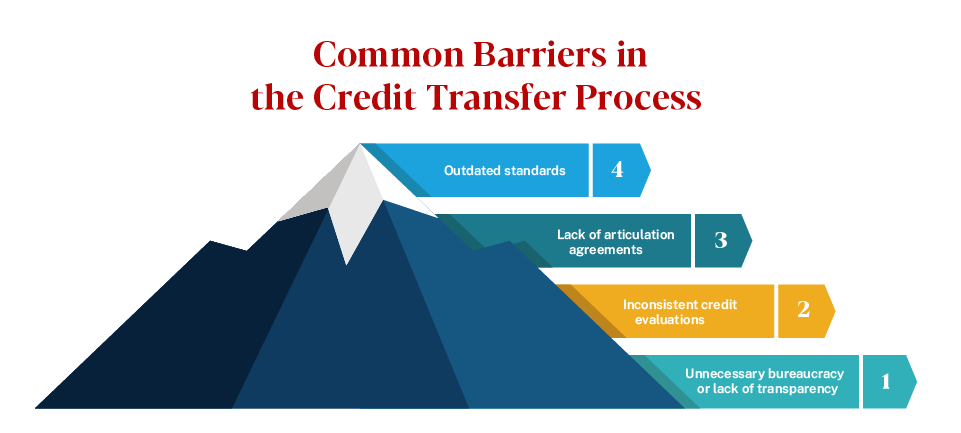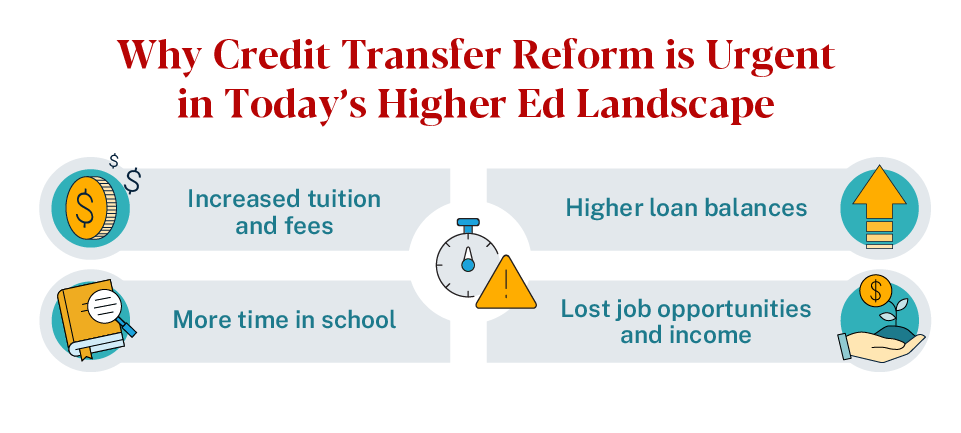
Today’s college students want the most out of their education. They look for flexibility, high-quality instruction and a direct pathway to their goals, whether that’s earning a degree, advancing a career or transitioning into a new field. While many colleges and universities can deliver on those promises, the college credit transfer process often falls short.
Instead of serving students efficiently, transferring credits can be confusing, inconsistent and frustrating. At a time when affordability and access matter more than ever, improving how credits move between institutions isn’t just desirable – it’s a necessity.
Learn more about how to transfer college credits, explore the drawbacks in the current system and see how schools like American College of Education (ACE) are leading the way in making transfer policies more transparent, efficient and student-centered.
Why Understanding the Credit Transfer Process Matters
If you’re currently grappling with the difficulties of transferring credits from one college to another, you are not alone. A 2025 Public Agenda survey with over 3,000 respondents found that two-thirds of the group experienced difficulties with the process.
But what exactly is a credit transfer?
In short, transferring credits means applying previously earned credits from another college or university toward your current degree program. When done right, transferred credits can help you earn a degree faster and at a lower cost. But when done poorly, it can waste your time, money and momentum. Without a clear system in place, students often encounter inconsistent standards, unclear guidelines and surprise rejections.
How to Transfer Credits From One College to Another
There is a general process most students follow when working with colleges and universities to evaluate transfer credits:
- Request official transcripts from your previous school(s) and send them to your intended institution.
- Meet with an admissions/enrollment counselor or transfer advisor to review which credits you earned may apply.
- See if there is an articulation (inter-institutional) agreement, which are generally pre-established agreements between schools that simplify credit recognition.
- Understand course equivalencies, especially in general education courses and the core curriculum.
- Review your credit evaluation to confirm what has been accepted and what hasn’t.
- Appeal, if necessary, if you believe a course should have been transferred but it didn’t.
Keep in mind, community college students often face a unique set of challenges when transferring to four-year institutions. Many assume that credits will transfer automatically, especially lower-level or general education courses, but this isn’t always the case. That’s why early advising and institutional transparency are so important.
Common Barriers in the Credit Transfer Process
Despite its importance, the credit transfer process is often plagued by roadblocks that frustrate students and stall progress. Some of the most common barriers include:
- Unnecessary bureaucracy or lack of transparency, where requirements are vague and advisors aren’t always clear about what is needed.
- Inconsistent credit evaluations across departments, especially if there’s no shared rubric or agreement in place.
- Lack of articulation agreements, which forces schools to re-evaluate each credit manually.
- Outdated standards and siloed systems that don’t account for real-world learning or new subject areas.
These inefficiencies can lead to students retaking classes they’ve already passed, delaying graduation and increasing student debt.

New Survey Finds Public Demand for Better Credit Transfer Policies
Public Agenda’s recent survey sheds light on just how frustrating the credit transfer process has become for students and families. The data reveals a system that, for many, feels unpredictable, overly complicated and stacked with unnecessary obstacles.
Key findings include:
- More than half of the survey’s respondents have experienced credit loss when attempting to transfer credits.
- 65% of respondents reported a negative experience when transferring college credits.
- 81% of respondents believe there should be a database that clearly identifies transferable credits.
- 88% of respondents support a process overhaul at institutions that have historically had poor transfer credit acceptance rates.
These findings reflect what many students already know firsthand: Transferring credits often means jumping through hoops, waiting on evaluations, and watching credits they earned and paid for get dismissed without clear explanation. The bottom line is students are frustrated, and they want a credit transfer system that puts their success first, not one that makes them start over.
Why Credit Transfer Reform is Urgent in Today’s Higher Ed Landscape
The broader higher education system is already under pressure. Rising tuition, declining enrollment and the national student debt crisis are causing students to question the return on investment (ROI) of a degree. The reality is that when students lose transferable credits, they face:
- Increased tuition and fees.
- More time in school.
- Higher loan balances.
- Lost job opportunities and income.
Put simply, failing to improve the transfer system isn’t just inconvenient – it’s expensive for a student. Institutions that streamline transfer policies can help students save money, graduate faster and experience a smoother academic journey.

How ACE Helps Students Keep What They’ve Earned
ACE understands that a student’s time is valuable and works to honor that time by finding as many ways as possible to grant their students academic credit for work or education they’ve previously completed. This is reflected in ACE’s clear transfer credit policies, as well as in how the college finds ways to recognize nontraditional credits.
ACE is breaking down barriers to academic credit in the following ways:
Complimentary transfer credit review: ACE offers prospective students the option of doing a preliminary assessment of the credits they have from previous institutions, even before the student has applied. The assessment lets students know about how many transfer credits they can expect to bring into ACE, and they can use this information to help them decide if ACE is the right school for them.
Articulation agreements: ACE has partnerships with community colleges that include articulation agreements, which provide assurance to students that their credits will seamlessly transfer into ACE’s programs without any issues. For some community colleges, ACE has even created concurrent enrollment pathways, where transfer students can start working toward their bachelor’s degrees at ACE while finishing up their associate degree program.
Credit for prior learning (CPL): ACE provides opportunities for students to receive academic credit from nontraditional, noncredit courses completed through programs or certificates. This is called CPL, and the college has a dedicated department working to evaluate and approve more of these pathways. This allows students to get more out of previously completed certifications or professional development programs, even if they were not done through a higher education institution.
Stackable program design: ACE has intentionally built many of its programs to be stackable, allowing their students to maximize the value of previously earned credits from ACE. Courses completed in a certificate program, for example, may also be part of a master’s program, which means students who have already completed the certificate can apply those courses directly to the master’s.
By giving students as much previous credit as possible, ACE saves students time and money. This is part of the reason why their graduates enjoy such a high rate of return on their educational investment. For every $1 ACE students invest in their education, they receive $19.20 in higher future earnings.
Solutions: What Institutions Can Do to Improve the Credit Transfer Process
Institutions that want to improve student satisfaction while optimizing trust and retention must prioritize changes to their credit transfer process. The path forward is clear:
- Streamline transfer policies to reduce ambiguity and manual credit assessments.
- Improve transparency by publishing clear transfer guides and data on outcomes.
- Recognize CPL and professional experience, not just classroom hours.
- Prioritize long-term ROI, helping students earn college credit that counts.
FAQs
Typically, college credits expire after five to 10 years. It depends on the subject and the institution. Fields like tech and healthcare may impose stricter limits due to rapid changes in knowledge.
Sometimes, but not always. Some schools may require you to retake courses if the content is outdated or the credit evaluation standards have changed.
The biggest issues stem from a lack of standardization, inconsistent school policies and outdated processes that haven’t kept up with modern student needs.
Our Approach is Simple: You
For too many students, transferring college credits is harder than it needs to be. From inconsistent evaluations to outdated systems, the current process often delays progress, increases costs and creates unnecessary stress. But it doesn’t have to be this way.
At ACE, we believe your hard work should count. Whether you’re coming from a community college, returning to school after a break or bringing in CPL, our team is here to help you navigate the process with clarity and confidence. We use trusted evaluation rubrics, keep tuition affordable and put your goals at the center of everything we do.
If you’re planning to transfer college credits or looking for a viable path to earn a degree, ACE is ready to help you move forward without starting over. Explore our fully online programs.

